Hearing protection consists in the elimination of harmful noise levels.
Remember!
To ensure the effectiveness of hearing protectors, you should always wear them when you are exposed to excessive noise levels. Improper use of the protectors may lead to hearing loss, balance disorder and other injuries.
The maximum permissible time of exposure to noise
The below table shows the approximate acceptable duration of exposure of a person without hearing protectors to various noise levels:
| Maximum exposure time | Exposure level |
| 8 hours | 85 dB |
| 4 hours | 88 dB |
| 2 hours | 91 dB |
| 1 hour | 94 dB |
| 30 minutes | 97 dB |
| 15 minutes | 100 dB |
| 7.5 minutes | 103 dB |
| 3.5 minutes | 106 dB |
As in the case of other risks, exceeding a certain level of noise may turn out to be harmful. This level is determined as 85dB for an 8-hour work day. If a worker is forced to work in conditions where the acceptable noise level is exceeded, the use of personal hearing protection equipment is necessary.
Long-term sound intensity exceeding 115dB is highly dangerous to people. In case of impulse noise this value cannot exceed 140dB (threshold of pain and potential risk of damage to the hearing organ).
This means that an effective hearing protector should not only provide appropriate sound insulation but also ensure a high degree of comfort during the entire work day.
There are three basic types of hearing protectors:
- ear muffs - including passive and active ear muffs. Depending on the attachment method there are banded ear muffs and ear muffs with a spring band at the back of the head (to be used alongside safety helmets or welding helmets),
- ear muffs - attached to a safety helmet,
- earplugs – inserted into the ear canal or pinna. They are manufactured either in the form of individual plugs or connected with a band or a cord. They may be reusable or for single use.
Usually the protective effect of hearing protectors is evaluated on the basis of SNR and HLM value.
SNR is a simplified indicator of noise level reduction (Simplified Noise Level Reduction, often referred to as Single Level Rating). It is a method for determining the performance of hearing protectors for a given noise level on the basis of conducted tests.
HLM provides more detailed information. H, L and M determine the performance of hearing protectors for high, medium and low frequencies.
Steps to follow when selecting appropriate hearing protectors:
- Indentify the type of noise: continuous, variable, impulse, amplitude,
- Measure the noise level at the workplace: intensity (dB) and frequency (Hz),
- Calculate the noise rate to be eliminated by hearing protectors maintaining the permitted noise level (80-85dB),
- Note that the protector should be suitable for use within the given bandwidth.
Usage and maintenance of hearing protection products
Roll down foam earplugs
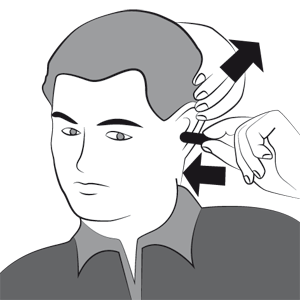
Usage
Roll the earplug lightly and squeeze the foam to form a narrow tube. Then, insert the plug well inside your ear canal. It is easier if you gently pull up the ear with your free hand.

Maintenance and cleaning
The earplugs have to remain clean and free of any materials which could damage the ear canal. They can be washed with a delicate liquid detergent and warm water.
The excess of water has to be removed be squeezing and the earplugs have to dry. The process can be repeated a few times.
The earplugs should be replaced when they stop being stiff or do not return to their original shape and size.
Reusable pre-moulded earplugs
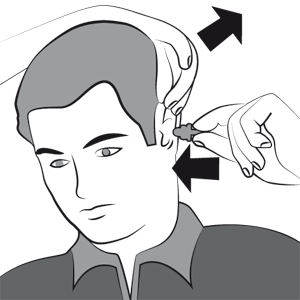
Usage
Reach to the back of your head, pull your ear up and insert the earplug inside the ear canal until you feel it fits. At first, you may feel it to be too tight, especially if you have never used earplugs before.
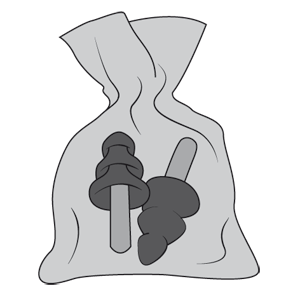
Maintenance and cleaning
Pre-moulded earplugs may be used for a period of a few months depending on their type, work environment, hygiene and physiology. They should be replaced if they shrink, become hard, tear, burst or they suffer permanent deformation. Wash with warm water.
Banded earplugs
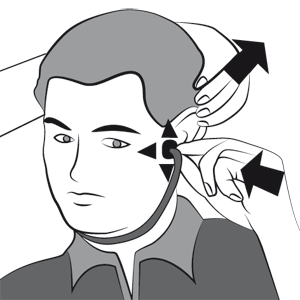
Usage
Holding by the wide end, adjust the earplugs to direct them towards the ear canal. Insert the ear pods using an inward motion and move them slightly inside the ear until you feel they fit. Sometimes, it helps when you pull your ear up.
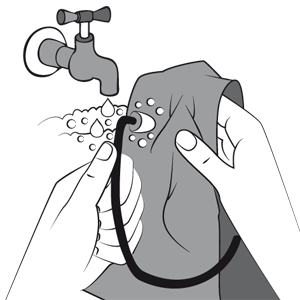
Maintenance and cleaning
Most of the hearing protectors of this type can be cleaned in the same way as the pre-moulded earplugs. You should not modify the band holding the ear pods as it may negatively affect protection levels provided by the device.
Hearing protectors
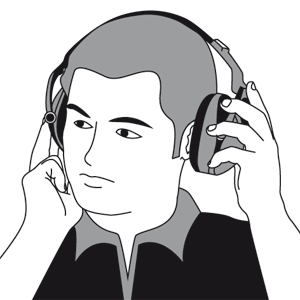
Usage
Hearing protectors should cover entire ears and fit snugly against the side of the head. The band should be adjusted in such a way as to ensure even pressure around the ears and the best soundproofing effect possible. You should remove your hair from under the earmuffs. You should not cover your ears, put a pencil or other things which could affect soundproofing behind your ear.
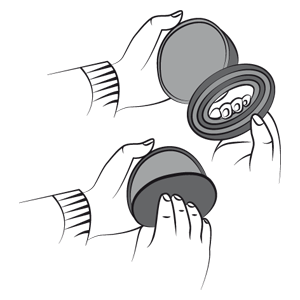
Maintenance and cleaning
The earmuffs can be washed with warm water and soap and then rinsed carefully. You cannot use alcohol or solvents. The sealing cushions have to be replaced at least twice a year or earlier if they become too stiff, burst or do not provide complete seal. The band should not be modified in any way, stretched or used improperly, as this may negatively affect protection levels.
List of standards for hearing protection equipment
Examples of noise sources
| INJURIES | 150 | Reverse thrust in jet engines |
| 140 | Jet engine starting | |
| 130 | Gunshot Pneumatic drill | |
| 120 | Aircraft propellers Chainsaw Forming press for metals | |
| 110 | Riveter Nailing machine, Blasting Pig Iron drop | |
| DANGER | 100 | Concrete leveling Barn at feeding time Abrasive blasting |
| 90 | Truck Food industry - bottling Food industry - packing Bandsaw Grinding Mill at work | |
| SAFETY | 80 | Heavy traffic Loud radio Vacuum cleaner |
| 70 | Car driving past | |
| 60 | The noise of busy office |
EN352-1
Hearing protectors. General requirements. Part 1: Ear muffs.
The first part of the standard specifies the requirements for construction, design and technical characteristics, test methods, marking regulations and information with which the users have to be provided.
According to the standard the information on the sound insulation level provided by the hearing protectors and measured according to EN24869-1 standard has to be provided.
EN352-2
Hearing protectors. General requirements. Part 2: Ear plugs.
The second part of the standard refers to ear plugs and specifies the requirements for construction, design, properties, test methods, marking regulations and information with which the users have to be provided.
The standard states that the information on the sound insulation level of the ear plugs measured according to EN24869-1 standard has to be provided. The standard determines the minimum level of sound insulation necessary to verify their conformity with the specification.
EN352-3
Hearing protectors. General requirements. Part 3: Ear muffs attached to industrial safety helmets.
The third part of the standard specifies the requirements for construction, design, properties, test methods and marking regulations concerning hearing protectors. Moreover, it determines the information with which the users should be provided if the protectors are to be mounted on safety helmets for industrial use.
The standard states that the information on the sound insulation level of the hearing protectors measured according to EN24869-1 standard has to be provided. The standard determines the minimum level of sound insulation necessary to verify their conformity with the specification.
EN352-4
Hearing protectors - Safety requirements and tests - Part 4: Level-dependent ear muffs.
The fourth part of the standard defines the requirements for level-dependent ear muffs. The standard specifies additional requirements for construction, design, properties, test methods, marking and information for users which result from the incorporation into the ear muffs the level-dependent system.
EN352-5
Hearing protectors. Safety requirements and testing. Part 5: Active noise reduction ear-muffs.
Described ear muffs with active noise reduction (ANR). Set additional requirements for the construction, design and operation, methods for testing, labeling, and information supplied to the user, resulting from the introduction to the ear-muffs actively reducing system noise.
EN352-7
Hearing protectors. Safety requirements and testing. Part 7: Level-dependent ear-plugs.
Described earplugs. Set additional requirements for the construction, design and operation, test methods, marking and information to be provided to the user.
EN352-8
Hearing protectors. Safety requirements and testing. Part 8: Entertainment audio ear-muffs.
Provides additional requirements for construction, design and operation, testing methods, labeling and information for the user, resulting from the introduction to ear-muffs electroacoustic devices.
EN458
Hearing protectors - Recommendations for selection, use, everyday and periodic maintenance - Cover document.
The standard contains recommendations for the selection, use, everyday and periodic maintenance of hearing protectors.